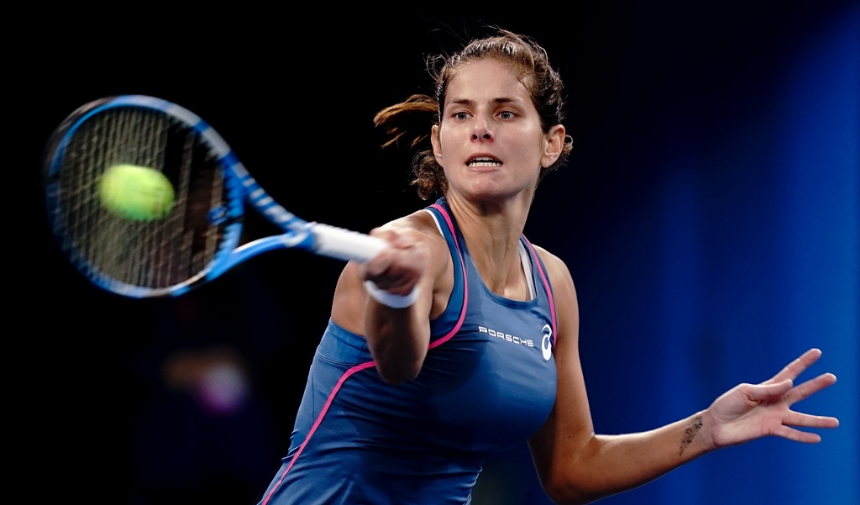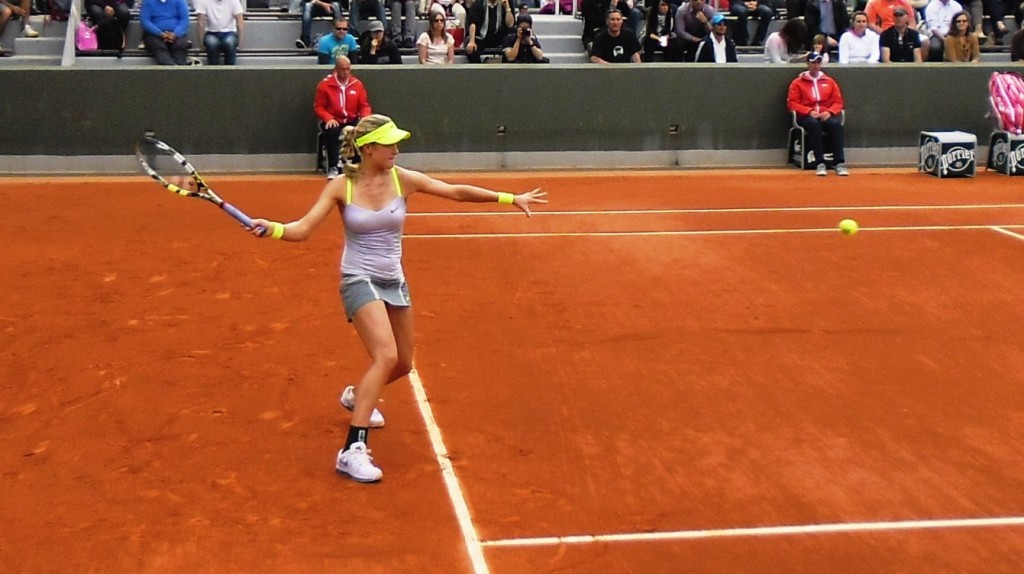Although I eventually decided against it, I was tempted to add “time and again” to the end of the title, to avoid any misunderstanding. So, I will clarify. It is not by winning the WTA Luxembourg Open that Julia Goerges “met the bar” this week. There is a lot more nuance to her run to the title than simply accomplishing what was expected on paper from the top-seeded player in the field. What must be emphasized here is the consistent way in which the ninth-ranked German “met the bar” every time she was challenged by her opponents and the stakes got higher.
Any coach/supporter will tell you that, while watching your player roll through matches with great overall performances may feel ecstatic, seeing him/her overcome challenging situations, making the right decisions under duress, and turning into a mental giant each time the score points to a critical stage, corresponds to a unique type of jubilation that satisfies at a far deeper level than one generated by watching him/her dominate an opponent during a routine win.
Let’s take a look at the key moments of the last three matches played this week by Goerges, her quarterfinal win over Donna Vekic, her comeback semifinal one over Eugénie Bouchard, and her victory over Belinda Bencic in the final.

Vekic took Goerges to a third set in the quarterfinals and pushed her hard in the final set. Down 2-3 and serving, Vekic saved three break points to hold and get back to 3-3. At the time, it felt like a significant momentum change in a match where each previous set had been decided by a single major momentum shift. When Goerges started that seventh game with a double fault, it felt like the beginning of a final shift in the match. Vekic’s chance to take command of the match had arrived.
Instead, Goerges popped a first serve to the “T,” and followed it up with a backhand down-the-line winner, classic execution of a 1-2 punch, to get to 15-15. Two points later, at 30-30, she pulled the trigger on a running forehand that forced Vekic into a defensive position. Goerges followed her shot to the net, but Vekic made a high – and impressive – retrieval that left Goerges little choice but to back up and hit a forehand swing-volley in the air from less than two meters inside the baseline. She smacked it right on the corner for a winner. She pumped her fist and let out her loudest scream of the match in relief. It was after all at 3-3, 30-30, in the third set, that she pulled those shots of her hat. Yet, that point alone was only a part of the whole.
Outside of the double fault to start that 3-3 game, Goerges committed no unforced errors from that point forward and won eight out of the last nine points to shut the curtains down on Vekic with a 6-3 3-6 6-3 victory. In that short segment, she also hit four winners and an ace.
In the semifinals, she faced qualifier Bouchard who had guaranteed her reentry to the top 100 by reaching the semifinal round and was riding a five-match winning streak, first one since her breakthrough year in 2014. Playing solid from the baseline and keeping the balls deep, Bouchard built a 7-6 5-3 lead on Goerges before the pendulum began tilting, sharply and suddenly, in the German’s favor.
Julia had her back against the wall when Bouchard served for the match at 5-4. It is true that Bouchard could not buy a first serve in that game and double-faulted at 15-15. Nevertheless, it also undeniably true that Goerges nailed three forehand winners on the most important points of the game. The first was to start it, the second at 30-30, the third to end it and earn the break. After Goerges held serve to grab the 6-5 lead, she broke the Canadian’s serve again at love, hitting two return winners in the process. In a matter of few minutes, she went from being two points away from defeat to starting a third set.
Although Goerges may have recorded a stunning +22 difference in the number of winners vs. unforced errors (48-26) for the match, the seven winners that she hit in those three games mattered the most. They came when she found herself in the do-or-die. They also bore dire consequences for her opponent Bouchard because Goerges never looked back, winning 10 out of the last 11 games to get past the Canadian 6-7 7-5 6-1 in two hours and two minutes.
In Saturday’s final, Goerges prevailed in two close sets to outlast the former top-ten player and qualifier Belinda Bencic and earn her second WTA title of the year. Bencic, the 21-year-old Swiss, is climbing back toward the top 20 after a miserable 2016 campaign that saw her suffer from a wrist injury, ultimately requiring surgery and causing her to plummet outside the top 100. She is currently ranked no.47 and poised to climb higher next week following her run this week.
On Saturday, both players had little trouble holding comfortably. For a player to take command, she either needed to pull a few magic shots on a return game, or her adversary had to gag points away on her serving game. Goerges did the former and pulled ahead. At 2-2, she exclusively went for bazooka returns on every point. She missed two out of the first three, going down 30-15. She made the next three, two of them resulting in clean winners, and the other, an almost-clean one. Four huge returns made brought Goerges the only break that she needed, to win the set.
It would not be fair though if I did not mention the 5-4 game. Goerges rode the early break until 5-4 and had the chance to serve the set out. She lost the first point when she sailed her forehand deep. She did not let the scoreboard pressure get to her. She served her first ace of the match to get to 15-15. Two points later, another big first serve brought her two set points at 40-15. She only needed the first. Another vintage 1-2 punch 3ending with a forehand winner put the first set in Julia’s pocket. It was perhaps her best serving game of the match, right when it counted the most.
In the second set, Goerges found herself serving at 4-5 to remain alive in the second set. She met the bar, yet again! Cool as a cucumber, she served four first serves to hold serve, one being an ace, the other two resulting in follow-up winners. In the next game on Bencic’s serve at 5-5, Goerges produced three more winners but also got an assist from her opponent when Bencic missed a high-forehand volley from the top of the net. That was the decisive break.
In the 6-5 game, Goerges earned her first match point at 40-0 when she served two aces and hit an unreturnable second serve. On her second match point at 40-15, Goerges pulled her umpteenth 1-2 punch winner to earn the title with a score of 6-4 7-5.
Goerges had 19 more winners than unforced errors (35-16), another spectacular spread in those numbers. She never faced a break point in the match. However, the stringing together of a few great points by Goerges at crucial junctures mentioned above played the largest role in deciding the match. Goerges seemed to find the extra gear whenever she needed it.
The above-noted segments from her last three matches are fresh in Goerges’s memory. When one uses the type of aggressive game that she plays, confidence can be the cornerstone of one’s performance. For three days and three matches, Goerges repeatedly met the bar, and that should mean something. I would not be surprised if a series of wins like these, combined with the title, propel her to a period of rapid improvement, perhaps even to the next level in her progress, whatever that may represent to her.
A baseline player who mainly operates on safe groundstrokes and consistency can maintain a certain level even during a down cycle in confidence. In the case of a striker like Goerges, down cycles can be painful and filled with an abundance of sprayed errors. At the same time, that which she can accomplish would have no limits if she can ride on a high degree of confidence and belief. If anything at all, the Luxembourg Open serves to bring Goerges closer to that ride.
Until next time…


